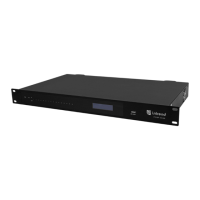Operating Manual for Digital Sound Processor (DSP) V3.0
WWW.INTREND-AV.RU
7
1.4 Float Point DSP
DSP device adopts analog device SHARC DSP, enabling 32-bit and 40-bit floating-point
processing, which can be compared to 40-bit floating-point processing of other devices.
Floating-point processing provides prominent advantages for the users in terms of sound quality
and usability.
Fixed-Point Processing Limitations
Fixed-point processing has its own disadvantages. If there is a significant change in gain,
data loss or more severe situation may occur, including clipping distortion. For example, for the
processing of 24-bit fixed point-based audio signal, in some cases, if you attenuate the signal to
42dB, the new signal only includes 17-bit information. Due to gain attenuation, 7-bit information
will get lost forever. More worse is the clipping distortion. For a signal nearly close to 0dBFS, the
signal will be clipped at 0dBFS and the audio distortion will occur. Even if the signal level is
adjusted to below 0dBFS through post-regulation, the clipping has occurred, and the distortion
still exists. Fixed point processing can help to create some headroom above 0dBFS. By doing so,
some bits have to be abandoned. For example, if a 12dB (2 bits) headroom is created, a 24-bit
system actually only has 22 bits.
Floating-Point Processing
In the contrary, by taking advantage of floating-point processing, no matter what the signal
level is, all available bits are uniformly distributed to the signals. Basically, the floating points use
some bits as indexes to set up general signal level and distribute the remaining bits to signals
with independently stored level. As a result, no matter what kind of level (from -200dB and 200dB
below to 0dBFS above, the stored signal's accuracy is optimized without clipping distortion.
SHARC provides 32-bit and 40-bit accurate processing; through 32-bit processing, 25 bits are
distributed to storage signals no matter what its signal level is. This means that, based on at least
1-bit low level signal, its accuracy is always significantly superior to 24-bit fixed point processing.
Through expanded 40-bit accurate processing, 33-bit storage signal can be achieved.
Practical Significance
What's the practical significance of floating point processing for the users? The gain stages
between multiple modules can be ignored. If the signal level of a module is reduced by 50dB
and is then restored to its original value through another processing, data loss will not occur. In
the fixed-point system, the users must check other signal levels before sending it to A/D
converter because all digital-to-analog converters adopt fixed points. In DSP system, if you

